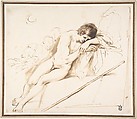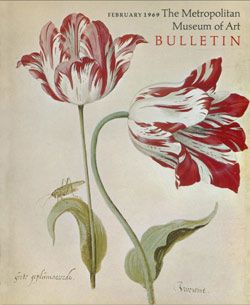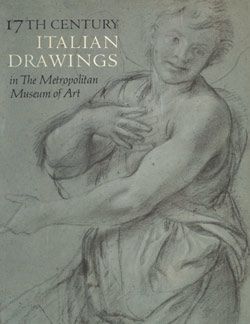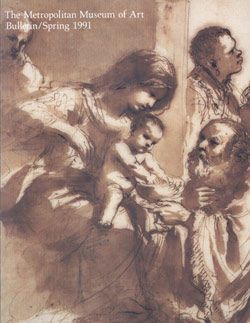Endymion Sleeping
Guercino (Giovanni Francesco Barbieri) Italian
Not on view
A naked shepherd slumbers for eternity in the moonlit landscape, his staff discarded at his side, his cloak gathered beneath his arms as a pillow. Perpetually young and handsome, Endymion is beloved by the moon goddess Selene-whose presence here is suggested by the waning crescent in the sky. The largely self-trained Bolognese artist Guercino (whose nickname means "squinty-eyed" in Italian) made this drawing in about 1650, at the height of his artistic maturity. He sketched the scene with characteristic energy, in sinuous lines of dark brown ink softened at the edges with fluent washes that shine against the white surface of the sheet.
Sir Denis Mahon (see here "References": Mahon 1967, p. 8) first considered this drawing to be a study for the now lost picture of Endymion in full length painted for Don Antonio Ruffo of Messina. The payments for this picture are recorded in a document of March 1650 (as published by Giampetrino Zanotti in Carlo Cesare Malvasia, Felsina pittrice, Vite de'pittori bolognesi, Bologna, 1841, vol. II, p. 331: Under the year 1650 - " Il dì 2 Marzo. / Dal Sig. Pietro Antonio Davìa si è ricevuto ducatoni N. 100 per parte del Sig. D. Antonio Ruffo da Messina, per pagamento dell' Endimione figura intera, e questi fanno lir. 500 e le monete furono dobloni N.17 che fanno dobble d'Italia N. 34 che sono lir. 503. 4 con il costo della cassetta, e subbio -- scudi 125 lire 3.4."). In all, Guercino's "Libro de' conti" (account book) records the painting of five pictures with Endymion as a subject, including the Davia picture over a period of fourteen years. Four of these specifically describe half-figures. The payments are recorded in Guercino's Libro dei conti in December 1644, September 1647, November 1657 and May 1658 (See Malvasia in Zanotti, 1841, pps. 325, 328, 338, and 338, respectively).
Only the picture executed for Don Antonio Ruffo depicted the sleeping Endymion in full length (see op. cit., p. 331, March 2, 1650). Guercino himself mentions this picture in a letter to Don Antonio Ruffo (dated March 16, 1650) as completed but not yet dry (see T.H. Fokker, Galleria Ruffo nel secolo XVII in Messina, con lettere di pittori ed altri documenti inediti, in Bolletino d' Arte, vol X, 1916, p. 98.) The museum's drawing is characterized by a simple outline, subtle figure modeling achieved with spare touches of wash, and thick pen and ink lines in the hair, as is typical of the 1630s. Shadows in obscured areas of the figure's head and eye sockets are achieved through a more concentrated application of pen and ink. Attention to surrounding details is minimal and the figure is foregrounded by spare layers of wash and parallel hatching, the use of which is also typical of his earlier style. The economic articulation of the landscape, indebted to Annibale Carracci's landscape studies, also ties this drawing to Guercino's earlier years. A drawing that combines this figure treatment with simple landscape elements is Two Nymphs and a Satyr, a study dated to the 1620s (London, Courtauld Institute Galleries, Witt Collection, inv. no. 1346). Autograph pen and wash drawings with a similar treatment of modeling and silhouette datable to the 1630s are Christ Appearing to Saint Theresa and Three Putti Amongst Clouds (both Royal Library, Windsor, inv. nos. 2782 and 2805, respectively) two pen and ink studies related to the painting Christ Appearing to Saint Theresa (1634) (Aix-en-Provence, Musee). Although a study for a clothed figure, the pen and ink Portrait of Cardinal Bernardino Spada (Haarlem, Teylers Museum, inv. no. H 103) datable to 1631, reveals a very similar treatment.
This image cannot be enlarged, viewed at full screen, or downloaded.
This artwork is meant to be viewed from right to left. Scroll left to view more.








